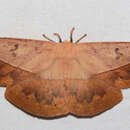pms
nòm ant ël fil


Lonomia achelous, the Brazilian caterpillar or giant silkworm moth caterpillar,[1] is a venomous caterpillar endemic to South America. The species was first described by Pieter Cramer in 1777.
These caterpillars measure 50 mm in length, have a thick, bristle-covered body which is greenish brown, and a dark brown or black head capsule. Juveniles are usually light green, and darken with age. The moth's eggs are light greenish yellow in the shape of a barrel; they are placed in suitable host plants. The moth has a coloration of several shades of pale to medium brown, the wings are similar to a dead leaf, has a dark central fixation at the tip of the wing.
During the larval phase they are nocturnal, and they feed on leaves of shrubs and several woody trees. They are usually grouped on trunks or at the bottom of the same plants during the day. The larvae are covered by pointed hollow spines (spicules), the venom is injected into any intruder when fixed on the skin and broken.[2]
It is found in South America, in Bolivia, Brazil, Colombia, Ecuador, French Guiana, Guyana, Peru, Suriname and Venezuela.[1]
Lonomia achelous venom has potent procoagulant and anticoagulant activity, Lonomin II and Lonomin I activate fibrinolysis, and Lonomin V is a Factor XIII protease, there's also a mild DIC with L. achelous envenomation attributable to procoagulant activity of Lonomin IV (Factor Xa-like activator). However, the main mechanism of L. achelous envenomation is intense fibrinolysis, as suggested by the prolonged eugoblin lysis time seen in almost all patients.[3]
Lonomia achelous, the Brazilian caterpillar or giant silkworm moth caterpillar, is a venomous caterpillar endemic to South America. The species was first described by Pieter Cramer in 1777.
Lonomia achelous es una especie de polilla de la familia Saturniidae, que se encuentra desde Colombia y Venezuela hasta la Guayana Francesa.[1]
La polilla adulta es de color ocre a amarillo anaranjado con una línea transversal color castaño en cada ala. La larva es de color marrón brillante, con líneas tenues marrón oscuro y una mancha blancuzca en forma de V en la cabeza;[2] presentan pelos o setas (scolus) con sustancias tóxicas que al contacto con la piel producen reacciones inflamatorias agudas y discrasias sanguíneas que pueden causar la muerte si no se aplica un suero antiveneno específico.[1]
Lonomia achelous es una especie de polilla de la familia Saturniidae, que se encuentra desde Colombia y Venezuela hasta la Guayana Francesa.
La polilla adulta es de color ocre a amarillo anaranjado con una línea transversal color castaño en cada ala. La larva es de color marrón brillante, con líneas tenues marrón oscuro y una mancha blancuzca en forma de V en la cabeza; presentan pelos o setas (scolus) con sustancias tóxicas que al contacto con la piel producen reacciones inflamatorias agudas y discrasias sanguíneas que pueden causar la muerte si no se aplica un suero antiveneno específico.
Lonomia achelous is een vlinder uit de familie nachtpauwogen (Saturniidae), onderfamilie Hemileucinae.
De wetenschappelijke naam van de soort is voor het eerst geldig gepubliceerd door Cramer in 1777.[1]
Bronnen, noten en/of referenties